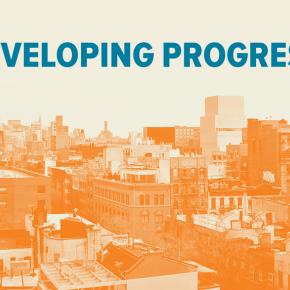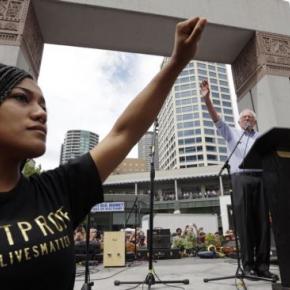The Fed, Full Employment, African-Americans, and an Event that Brings It All Together
Jared Bernstein Blog - March 3, 2015 - As a tireless (some would say tiresome) advocate for full employment and the benefits it yields for working people, you can imagine how I was thrown by this...
Jared Bernstein Blog - March 3, 2015 - As a tireless (some would say tiresome) advocate for full employment and the benefits it yields for working people, you can imagine how I was thrown by this NYT headline over a piece by economics reporter Bin Appelbaum:
Black jobless rates remain high, but Fed can’t do much to help.
“Shots fired!” as the kids say.
I find this hard to believe in the following sense. Black unemployment has averaged almost twice that of overall unemployment since the monthly data begin in 1972 (avg: 1.9, with standard deviation of 0.15, so not a ton of variation around that mean). Crudely, that implies that if overall unemployment fell from 6% to 5%, the black rate might fall more in percentage point terms, from 12% to 10%.
Next, if the Fed can push down the overall unemployment rate, which is certainly within its purview and, at a time like this, its job description, then the headline seems off.
Now, there are important nuances in play here.
First, these relationships are not always so clean. Over the long, strong recovery of the 1990s, black unemployment fell 4.5 points compared to 2.1 points for whites (and 2.5 points overall). Over the 1980s recovery, black unemployment—which was about 20% at the end of the deep early 1980s recession—fell 8.5 points compared to 4.7 for whites.
Those comparatively big declines show the disproportionate benefits that blacks reap from lower unemployment and, conditional on the Fed’s ability to lower unemployment, they belie the NYT headline. I could make similar claims based on wages and incomes, but I’m bound by secrecy for now (more on that in a moment).
However, more recently, that relationship isn’t generating such impressive results. Over this recovery, black and white unemployment have declined by similar amounts (4.5 points for blacks; 3.8 for whites). And, as Appelbaum points out, real median wages have fallen twice as much for blacks as for whites.
But that’s kinda the point: until recently this has been a uniquely weak recovery, and as such, tells us little yet about the extent to which full employment will lift the relative economic fortunes of black workers.
If we get to and stay at full employment, I’m confident it will work as it has in the past, based both on the history briefly cited above and on some truly exciting results from a new paper we’ve commissioned for our full employment project on the benefits of full employment to black workers, written by the economist Valarie Wilson from the Economic Policy Institute.
Valerie will be highlighting the results at an event we’re holding in DC on March 30th so far be it from me to steal her thunder. But she’s got some panel data regressions (which provide lots more observations and variance than the simple time series comparisons noted above) showing the impact of lower unemployment on black compared to white median wages, and man…all’s I can say is I’m employing great restraint not to just print them right here and now!
Here’s another point worth considering. Various economists on team full employment have been trying to get the Fed to hold off on its interest rate liftoff, but Appelbaum writes: “It’s not obvious, however, that holding down borrowing costs for a little longer would be an effective way to address the underlying problem. Indeed, the problem is a good illustration of the limits of monetary policy.”
That may be true in the following sense: if the Fed raises rates a little bit in 2015q4 instead of 2015q3, I doubt it will matter that much to anyone in the real economy (though financial markets would make a huge deal out of it). Similarly, if they hold to a 5.4% full employment rate and a firm 2% inflation ceiling that mustn’t be breached, or if they shift from being data driven to shooting at the phantom menace of inflation that’s allegedly hiding out of sight from the data just around the corner—well then, yeah, they won’t much help those who depend on lasting full employment to catch a break.
He’s also got a point re underlying problems. Even full employment may not be enough to reach the millions of workers with criminal records who face uniquely high barriers to the job market. I’ve written about fair-hiring policies to reach these workers, and so has Appelbaum.
But check this out: I mentioned our March 30 event. Well, another speaker on the panel that morning will be the guy from whom I learned all I know about fair-hiring, Maurice Emsellem from the National Employment Law Project.
I know what you’re thinking: what about macro, what about Fed policy? How can you call yourself a full employment maven and leave that out? Did I forget to mention our keynote speaker? A fella named Bernanke…Ben Bernanke. Here’s the flyer. Be there and be square.
Source
Toys 'R' Us and the Death of Retail
When Debbie Beard found out the company she'd worked at for 29 years, Toys R Us, was closing down, she was shocked--she knew the company had been having financial difficulties for a while, but...
When Debbie Beard found out the company she'd worked at for 29 years, Toys R Us, was closing down, she was shocked--she knew the company had been having financial difficulties for a while, but didn't realize it was that bad. The more she learned, though, about the way the company had been looted by private equity firms Bain Capital and KKR, the more she determined that no one else should have to go through this. Debbie and other Toys R Us workers are organizing to demand severance pay from the company, and beyond that, organizing to stop the kind of leveraged buyouts that saddle viable companies with unsustainable debt. She joins me along with Carrie Gleason of the Fair Workweek Initiative at the Center for Popular Democracy to explain what can be done.
Read the full article here.
‘Inflation Dynamics’ With the Fed as Ringmaster
In the center ring, Federal Reserve brass will be gathering for the closed-door conference that is hosted annually by the Kansas City Fed. Janet Yellen is skipping the event, as chairs of the...
In the center ring, Federal Reserve brass will be gathering for the closed-door conference that is hosted annually by the Kansas City Fed. Janet Yellen is skipping the event, as chairs of the board of governors occasionally do. The town, though, will be full of her critics.
On the right, the American Principles Project will host a separate parley on the need to reform the monetary system by restoring the gold standard as the best route to full employment.
In the left ring, a third group, called Fed Up, will argue for placing a priority on job creation. The Washington Post reports that the organization’s “teach in” will cover “income inequality, efforts to raise the minimum wage to $15 an hour and whether the Fed should invest in municipal bonds.”
The Fed and its critics will be gathering as a bill to establish a Centennial Monetary Commission goes to the floor of the House. The bill would establish a commission to examine the Fed as it begins its second century.
At the Fed’s conference—the theme is “Inflation Dynamics”— one speaker will be the Fed’s vice chairman, Stanley Fischer. Earlier this month, in an interview with Bloomberg News, he seemed to suggest that the dollar wasn’t losing value fast enough for the Fed’s taste.
MarketWatch headlined the interview as suggesting that a rate hike in September is “not a done deal.” The collapse of stock markets around the world in recent days, says USA Today, gives the Fed a “new excuse” not to raise interest rates.
No doubt Fed Up, part of the Center for Popular Democracy, will make the most of it. In addition to pressing for keeping interest rates near zero, the group is lobbying for more labor and consumer advocates on boards of regional Federal Reserve banks. Fed Up also wants easy money. “Fed policy has been too tight for the past 40 years,” Fed Up Director Ady Barkan emails me. “The commitment to keeping inflation low at all costs is what has led to the elevated levels of unemployment.”
The focus of the American Principles Project—with its gathering of economists, political leaders, bloggers and activists— will be less on what the Fed should do and more on whether central banks are the problem and how Congress should use its powers for reform.
I wonder whether there might be surprising convergence between the left and right camps. American Principles is also focusing on employment but sees as critical to job creation the return to a dollar that is an honest unit of account defined in law and backed by gold.
One of the group’s presenters, Marc Miles, is likely to report on a new study showing that higher interest rates correlate to job creation. Has the Fed pursued the wrong policies as it has used its mandate, legislated in 1978 with the passage of the Humphrey-Hawkins Full Employment Act, to boost employment?
When the law created the Fed’s so-called dual mandate by obliging the central bank to aim for full employment in addition to maintaining price stability, even the New York Times called the measure a “cruel hoax.” Considering whether to end the dual mandate is one of the questions that would be taken up by the Centennial Monetary Commission on which the House is preparing to vote.
So would the question of whether a rules-based system, such as that proposed by economics professor John Taylor, could solve the problem of fiat money that is not defined in law. Congress has already started looking at these matters.
Fed Chair Yellen has bridled at such ideas. Earlier this year she suggested that she would oppose any rule of monetary policy making. At Jackson Hole three years ago, then-Chairman Ben Bernanke warned Congress to, as the Drudge Report headlined it, “butt out” of interest-rate policy discussions.
The fear at the Fed is that Congress will politicize the formation of monetary policy. That strikes me as a weak line. The Constitution, which all Fed chairmen swear to support, grants monetary powers to Congress, precisely to the most political branch of the government.
We are approaching the end of a presidency that has been hobbled by an underperforming economy. No wonder the Fed’s most celebrated annual gathering is now bracketed by competing conferences that seek political reform of monetary policy. The big question is whether Congress and the presidential candidates are listening.
Source: Wall Street Journal Asia
Concerns About New Part-Time Work Trends and Proposed Remedies
The Diane Rehm Show - August 7, 2014 - The number of people working part-time who would rather work full-time is almost double what it was seven years ago at 7 million people. Despite signs of...
The Diane Rehm Show - August 7, 2014 - The number of people working part-time who would rather work full-time is almost double what it was seven years ago at 7 million people. Despite signs of economic recovery, many businesses say they are still struggling and depend on part-time workers, especially those who work on-call. New federal data show that almost half of all part-time workers under age thirty-two work unpredictable hours, leaving them with reduced paychecks and scrambling for child-care. A discussion about the latest trends in part-time work and the push for new laws that protect employees. Listen to the full program here.
Developing Progress: Ensuring that public resources contribute to New York’s equity, resilience, and dynamic democracy
Progressive development policies that ensure consideration of economic, social, and environmental impacts will grow a city that is equitable, resilient, and democratic. While stimulating new...
Progressive development policies that ensure consideration of economic, social, and environmental impacts will grow a city that is equitable, resilient, and democratic. While stimulating new revenues for the city, progressive development policies will also promote the economic and environmental sustainability of our communities and provide good jobs to both construction and permanent employees.
Download the report.
Each year New York City invests $2 billion to encourage private development, but it does not require progressive development practices, transparency about job creation or other contributions to community well-being, or accountability to benchmarks that could demonstrate the return on this investment.
Starwood Capital Group’s track record for development in New York City provides a good example of the problems with the current approach to the public’s investment. While some Starwood developments meet responsible development standards, others endanger workers and other community members. Notably, on its publicly subsidized project at Pier 1 in Brooklyn Bridge Park, Starwood has partnered with a general contractor with a history of safety violations and alleged illegal behavior.
Examples like the Pier 1 project highlight the need for higher standards with stronger enforcement on projects the public invests in. Brooklyn Bridge Park – particularly, the development of Pier 6 there – offers the city an opportunity to develop principles, institute policies, and enforce standards to ensure that public resources contribute to New York’s equity, resilience, and dynamic democracy.
We recommend that immediate steps be taken as a broader set of progressive development policies takes shape:
The request for proposals for development of Brooklyn Bridge Park’s Pier 6 should include strong, clear criteria to promote the economic and environmental sustainability. Starwood Capital should use only responsible contractors and subcontractors on the Pier 1 project. Pension funds should withhold future investments with Starwood Capital until the group meets the pension funds’ Responsible Contractor standards. Developers should be legally accountable and culpable for the safety, health, and environmental conditions on their worksites. Penalties for violations of safety, health, building, and environmental standards, as well as for violations of community benefits and other agreements in public contracts should be raised.Download the full report here.
National advocacy groups are backing the sick-leave effort in Texas

National advocacy groups are backing the sick-leave effort in Texas
National advocacy groups based mostly in Washington, D.C., and Brooklyn, N.Y., were responsible for $1.8 million of the $2.5 million contributed and loaned to the political action committee...
National advocacy groups based mostly in Washington, D.C., and Brooklyn, N.Y., were responsible for $1.8 million of the $2.5 million contributed and loaned to the political action committee leading the effort to mandate paid sick leave for workers in Texas...The other major outside donors include...$95,000, Center for Popular Democracy, Brooklyn, N.Y.
Read the full article here.
Black Community Seeks the Power of the Ballot
Source: Vox
For black communities in the United States, presidential election participation rates are strong and momentum is building.
In 2012, black voters showed up at the polls in the largest numbers (66.2 percent) and voted at a higher rate than non-Hispanic whites (64.1 percent) for the first time since rates were published by the U.S. Census Bureau in 1996.
Black Americans tend to vote Democratic in presidential elections. This was true by historic margins in President Barack Obama's 2008 and 2012 victories— 95 and 93 percent, respectively. And their turnout rate in 2016 could be an important factor in deciding the next president of the United States, especially in a tight race.
That's good news for black community leaders who want to ensure their voices are heard and hold future leaders accountable.
Civil rights leadership
The 2014 and 2015 cases of deadly police force against unarmed African-Americans have galvanized a tech-savvy generation of activists to inject new life in an age-old push for racial, economic and social equality.
More and more, movements such as Black Lives Matter are becoming international household names and are holding candidates accountable to specifically address and push for legislation on these issues.
One such organization, Black Alliance for Just Immigration (BAJI), engages and advocates on behalf of African-American and black immigrant communities on issues of racial justice and immigrant rights.
BAJI's policy and legal manager, Carl Lipscombe, says part of the greater push nationwide to organize and bring to light instances of police brutality results from what he describes as a community-wide fear of "being killed when walking to the corner." He says these police cases are enhanced by the advent of social media and by the ability to capture events on camera that wasn't possible in the 1980s.
Lipscombe says candidates must do more than "throw a bone" if they expect communities of color to go to the polls in droves.
"It's not enough to just say we want free education for everyone," Lipscombe said. "We want to know how this is going to impact black people."
According to the U.S. Bureau of Labor Statistics, the unemployment rate among blacks in the United States, at 9.4 percent, remains significantly higher — nearly double — than the overall rate of 5 percent nationwide.
Black wealth also has declined. The non-partisan Economic Policy Institute, in coordination with the liberal research institution Center for Popular Democracy, reports that black workers' wages have fallen by 44 cents on the hour in the past 15 years, while wages of both Hispanic and white workers have increased by approximately the same amount.
African immigrant concerns
The Migration Policy Institute reports that black immigrants from Africa are better educated than the overall U.S. population, age 25 and older.
In 2007, 38 percent held a four-year degree or more, compared to 27 percent of the U.S. population. Yet, black immigrants earn lower wages and hold the highest unemployment rate in comparison to other immigrant groups, according to the Center for American Progress.
Bakary Tandia, case manager and policy advocate at African Services Committee, a Harlem-based agency dedicated to assisting African immigrants, refugees and asylees, says progress is necessary across all levels of government.
"Even if you take the case of [New York City Mayor Bill] de Blasio,” Tandia said, “he is a progressive mayor, but in his administration, I have not seen any African immigrant appointed or in a meaningful position, and the same thing goes at the state level, at the federal level."
New leadership
Grass-roots coordinators say anti-immigration rhetoric among some presidential candidates has fueled electoral participation, as well as greater community leadership.
Steve McFarland, whose organizing efforts include get-out-the-vote campaigns among disenfranchised communities in New York, says the immigration reform movement, combined with the work of Black Lives Matter, has produced a new generation of civil rights leaders.
"It doesn't look the way that it used to look," McFarland said. "It's not big organizations, but they can mobilize people, they have a clear voice, and they are winning changes across the country."
Ahead of the 2016 presidential primaries, there is good news for Democratic frontrunner and former secretary of state Hillary Clinton. She currently enjoys an 80 percent favorability rating among adult blacks, the highest positive net rating of all candidates, according to a recent Gallup poll.
Clinton, who has met privately with Black Lives Matters activists, specifically addressed racial profiling in an October speech at Clark Atlanta University.
"Race still plays a significant role in determining who gets ahead in America and who gets left behind," Clinton said. "Racial profiling is wrong, demanding, doesn't keep us safe or help solve crimes. It's time to put that practice behind us."
Internal Emails Show ICE Agents Struggling to Substantiate Trump’s Lies About Immigrants

Internal Emails Show ICE Agents Struggling to Substantiate Trump’s Lies About Immigrants
As hundreds of undocumented immigrants were rounded up across the country last February in the first mass raids of the Trump administration, Immigration and Customs Enforcement officials went out...
As hundreds of undocumented immigrants were rounded up across the country last February in the first mass raids of the Trump administration, Immigration and Customs Enforcement officials went out of their way to portray the people they detained as hardened criminals, instructing field offices to highlight the worst cases for the media and attempting to distract attention from the dozens of individuals who were apprehended despite having no criminal background at all.
Read the full article here.
Support the Farmworkers Fasting to End Sexual Assault in Wendy’s Supply Chain

Support the Farmworkers Fasting to End Sexual Assault in Wendy’s Supply Chain
“This year marks a decade since the 2008 financial crisis—and many of those affected have...
“This year marks a decade since the 2008 financial crisis—and many of those affected have yet to recover. As part of its campaign to demand that the New York Federal Reserve pick a president that will stand up to Wall Street, the Center for Popular Democracy is collecting stories from those affected by the crash. Watch and share some of those stories, then submit your own.”
Read the full article here.A Call to Action From NMAC & Housing Works
People in the movement might be surprised by a joint letter from Charles King of Housing Works and me, but these are not ordinary times. NMAC is writing this letter to invite constituents at this...
People in the movement might be surprised by a joint letter from Charles King of Housing Works and me, but these are not ordinary times. NMAC is writing this letter to invite constituents at this year’s United States Conference on AIDS to join Housing Works efforts on Wednesday, September 6, to greet Congress on its return from summer recess with a rally for the care we need to survive—sign up here!
These are confusing times with no clear roadmap. Since NMAC is hosting the HIV/STD Action Dayon the same day, we want everyone to be aware of our mutual support and collective goal to not just save the Affordable Care Act, but to also strengthen our vision of ending AIDS as an epidemic. This can only happen when affordable health care becomes a human right for everyone.
Read the full article here.











2 months ago
2 months ago